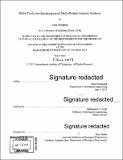RNA tools for optimization of multi-protein genetic systems
Author(s)
Ghodasara, Amar
DownloadFull printable version (10.10Mb)
Alternative title
Ribonucleic acid tools for optimization of multi-protein genetic systems
Other Contributors
Massachusetts Institute of Technology. Department of Biological Engineering.
Advisor
Christopher A. Voigt.
Terms of use
Metadata
Show full item recordAbstract
Balancing protein expression is critical when optimizing genetic systems. Typically, this requires construction of a library where variants of parts (e.g. promoters) are tried for each gene, which can be expensive and time-consuming. Here, we present an approach that leverages transacting RNA regulators to explore large gene expression spaces without de novo library construction. First, we developed six sRNAs whose strengths have been optimized against a set of 15nt "target" sequences that can be inserted upstream of a ribosome-binding site to generate up to 175-fold repression when maximally expressed. By controlling sRNA expression, the targeted gene can be tunably repressed from 1.6- to 121-fold. We then built a pool where each of the six sRNAs was placed under the control of 16 promoters, yielding ~107 combinations. This pool can optimize up to six genes in any system. Only a single variant of the system is constructed, where a target sequence is placed upstream of each gene. This is then transformed with the pre-built sRNA pool and the resulting library is screened. The system is then rebuilt by rationally selecting parts that reproduce the optimal knockdown of each gene identified by the screen. We demonstrated the versatility of this tool by using the same pool to optimize a beta-carotene pathway and an XNOR circuit. In a second study, we developed tools to facilitate a similar approach in yeast using CRISPRi. We leveraged T7 RNA polymerase to produce guide RNAs (gRNA), and show that modulating gRNA levels with T7 promoters can regulate gene expression. As a proof of principle, we used this system to modulate flux in a carotenoid pathway. Together, the tools presented in this thesis drastically reduce the time and cost to optimize multi-gene systems in a variety of organisms.
Description
Thesis: Ph. D., Massachusetts Institute of Technology, Department of Biological Engineering, 2017. Cataloged from PDF version of thesis. Includes bibliographical references (pages 115-124).
Date issued
2017Department
Massachusetts Institute of Technology. Department of Biological EngineeringPublisher
Massachusetts Institute of Technology
Keywords
Biological Engineering.